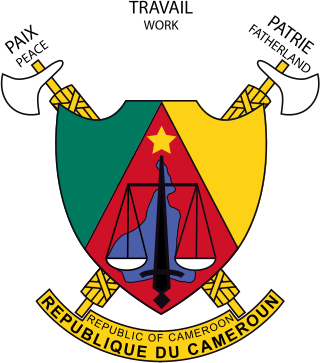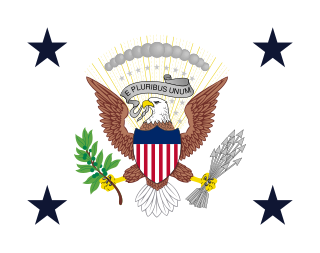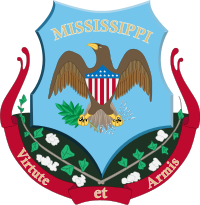
The Great Seal is a principal national symbol of the United States. The phrase is used both for the physical seal itself, which is kept by the United States secretary of state, and more generally for the design impressed upon it. The obverse of the Great Seal depicts the national coat of arms of the United States while the reverse features an unfinished pyramid topped by an Eye of Providence. The year of the U.S. Declaration of Independence, 1776, is noted in Roman numerals at the base of the pyramid. The seal contains three Latin phrases: E Pluribus Unum, Annuit cœptis, and Novus ordo seclorum.

The coat of arms of the state of New York was formally adopted in 1778, and appears as a component of the state's flag and seal.

The coat of arms of the Philippines features the eight-rayed sun of the Philippines with each ray representing the eight provinces which were placed under martial law by Governor-General Ramón Blanco Sr. during the Philippine Revolution, and the three five-pointed stars representing the three major island groups of Luzon, the Visayas, and Mindanao.

The coat of arms of Cameroon consists of a shield with a banner above and below it. Behind the shield are two crossed fasces. The shield has the same color pattern as the flag of Cameroon, and in the center is a map of the nation. The scales of justice are superimposed on top of the map of the nation since 1998.

The coat of arms of Poland is a white, crowned eagle with a golden beak and talons, on a red background.

The coat of arms of Toronto is a heraldic symbol used to represent the city Toronto. Designed by Robert Watt, the Chief Herald of Canada at the time, for the City of Toronto after its amalgamation in 1998. The arms were granted by the Canadian Heraldic Authority on 11 January 1999.

The seal of the president of the United States is used to mark correspondence from the president of the United States to the U.S. Congress, and is also used as a symbol of the presidency itself. The central design, based on the Great Seal of the United States, is the official coat of arms of the U.S. presidency and also appears on the presidential flag.

The Great Seal of the State of Hawaii was designated officially by Act 272 of the 1959 Territorial Legislature and is based on the territorial seal. Modifications to the territorial seal included the use of the words "State of Hawaii" at the top and "1959" within the circle. Provisions for a seal for the state of Hawaii were enacted by the Territorial Legislature and approved by Governor William F. Quinn on June 8, 1959. The passage of the Admission Act in 1959, admitted Hawaii as the 50th State of the United States of America on August 21, 1959.

The coat of arms of Malta is the national coat of arms of the country of Malta.

The Great Seal of the State of New Mexico is the official seal of the U.S. state of New Mexico. It is enshrined in Article V, Section 10, of the New Mexico State Constitution, which requires a state emblem to be kept by the secretary of state for official documents and other expressions of statehood. Rooted in the official seal of the New Mexico Territory established in 1851, it was adopted in 1913, one year after New Mexico was admitted as the 47th state.

The national emblem or coat of arms of Indonesia is called Garuda Pancasila. The main part is the Garuda with a heraldic shield on its chest and a scroll gripped by its legs. The shield's five emblems represent Pancasila, the five principles of Indonesia's national ideology. The Garuda claws gripping a white ribbon scroll inscribed with the national motto Bhinneka Tunggal Ika written in black text, which can be loosely translated as "Unity in Diversity". Garuda Pancasila was designed by Sultan Hamid II from Pontianak, supervised by Sukarno, and was adopted as the national emblem on 11 February 1950.

The Great Seal of the State of Alabama is the state seal of the U.S. state of Alabama.

The Great Seal of the State of Mississippi was adopted in 2014, replacing a previous version that was used since the 19th century.

The current national emblem of Sudan was adopted in 1985.

Naval heraldry is a form of identification used by naval vessels from the end of the 19th century onwards, after distinguishing features such as figureheads and gilding were discouraged or banned by several navies.

The coat of arms of the Department of Bolívar is the official coat of arms of the Department of Bolívar. The coat of arms had been in used before 1856, but in that year the Sovereign State of Bolívar was created, and its symbols changed; the new coat of arms, would be the same as the coat of arms of Colombia but with a red oval around it, that read “ESTADO SOBERANO DE BOLIVAR”. In 1886 the states were suppressed and departments created instead, the symbols were used once again but the originals were corrupted and so there are some variations on the current coat of arms, and that which was specified on the blazon.

The coat of arms of the Republic of South Sudan was adopted in July 2011 following independence from the Republic of Sudan. Prior to independence, South Sudan was an autonomous region of Sudan.

The seal of the vice president of the United States is used to mark correspondence from the U.S. vice president to other members of government, and is also used as a symbol of the vice presidency. The central design, directly based on the seal of the president of the United States, is the official coat of arms of the U.S. vice presidency and also appears on the vice presidential flag.

The flag of the vice president of the United States consists of the U.S. vice presidential coat of arms on a white background, with four dark blue stars in the corners. A version of the flag is kept in the vice president's office, is sometimes displayed by the vice president in official photos, and is flown on the vice president's motorcade.
A national coat of arms is a symbol which denotes an independent state in the form of a heraldic achievement. While a national flag is usually used by the population at large and is flown outside and on ships, a national coat of arms is normally considered a symbol of the government or the head of state personally and tends to be used in print, on armorial ware, and as a wall decoration in official buildings. The royal arms of a monarchy, which may be identical to the national arms, are sometimes described as arms of dominion or arms of sovereignty.






















